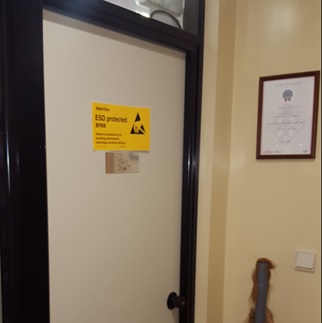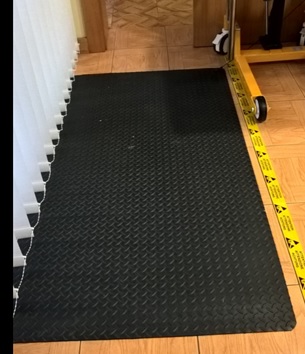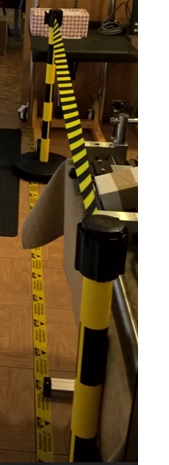ESD STANDARDS
OBJECTIVES
The materials manufactured by Fagor Automation are of the "ESD - Electrostatic Sensitive Device" class, which implies that the SNC has laboratories that comply with "ESD" specifications.
"ESD" laboratories are intended to increase reliability, avoiding problems, during and after repair, as explained below.
Static electricity is a major cause of breakdowns in electronic equipment, often invisible, difficult to diagnose and may even manifest only several days after discharge. It is imperative for the quality increase to exist a control of this type of events and to minimize them to the maximum. Static electricity results from electric charges generated by friction - triboelectric, namely people walking, fluids moving in a tube, etc.

Loads are accumulated on the surfaces of objects and people,and can have high values.

According to the above table it can also be verified that the relative humidity of the air helps to dissipate this type of energy.
A summary provided in the literature and which should be retained:
To control these electrostatic charges, it must be defined which equipment is sensitive and the places where the manipulation rules of such equipment will be applied.
In defined areas, the quantity of loads produced must be minimized and techniques for unloading can be avoided. In this way, the ESD project should contemplate the definition of demarcated rules and zones and the people training. One of the basic principles that must be followed is to put all materials and people to the same potential, linked by mats, bracelets, etc.., if there is no potential difference there will be no discharges.
Definitions
In general, all equipment that does not have its own metal box or box is open and that allow you to play directly on the circuits and electronic components.
They are also components that are already inside packages that are identified with the symbol:

TRIBOELETRIC - The creation of electrostatic charge by contact and separation of materials is known as "triboelectric." The word "triboelectric" comes from the Greek words, tribo - meaning "rub" and elektros - meaning " 'amber' (fossilized resin from prehistoric trees). It involves the transfer of electrons between materials.

The atoms of a material without a static charge have an equal number of (+) positive protons in their nucleus and negatives to orbit the nucleus. In Figure 1, the material "A" consists of atoms with equal numbers of protons and electrons. Material B is also composed of atoms with equal (though perhaps different) numbers of protons and electrons. Both materials are electrically neutral.

When the two materials are brought into contact and then separated, the negatively charged electrons are transferred from the surface of one material to the surface of the other material. Which material that loses electrons and what material does the electron gain? It will depend on the nature of the two materials. The material that loses electrons becomes positively charged, while the material that gains electrons is negatively charged. This is shown in the figure above.
AREAS OF INTEREST IDENTIFICATION
The areas of ESD interest are spaces where there are tools, means and conditions that minimize the presence of electrostatic charges and where every effort should be made to keep this level low.
In these areas it is safer to handle and open packages containing sensitive equipment. These areas are marked with the symbol:

Proximity alert symbol to the handling area of ESD-sensitive equipment

Oporto’s Lab - Access by room 214

Oporto’s Lab - Access to the lab

Oporto’s Lab - Access by room 212
ALSO SHOULD BE DELIMITED BY THE TAPE:

ESD zone boundary tape

ESD mat in laboratory Marinha grande delimited by ESD zone delimiting tape

Access to Marinha grande’s Laboratory - ESD zone input indicator tape

ESD mat in Porto’s Laboratory delimited by ESD zone delimiting tape

ESD walk-through mat in Oporto’s Lab

Access to Oporto’s Lab - ESD zone input indicator strip
These areas of interest should be monitored for relative humidity which should not be less than 50% nor more than 90%.
IDENTIFICATION OF PERSONS OF INTEREST
IDENTIFICATION OF TOOLS NEEDED
The following needs were identified following the field survey:
The work station handling sensitive equipment should be composed of carpets on the countertop and floor to dissipate electrostatic energy. They must be properly grounded securely.

Workstation mat

ESD connection point

Clothing - Operators must be equipped with clothing to assist in dissipating electrostatic charges, in particular work gowns, shoehorn and bracelets.

ESD Clothing
Clothing must be stored in a visible place and easily accessible outside the ESD
Place of work gowns in Marinha Grande
Number of people expected in the laboratory: 2
The cleaning equipment operations must take into account the generation of loads. Appropriate brushes should be used.

Work tools, welding stations, and hand tools should promote the disposal of electrostatic charges.
| Quantity | Description |
| 1 | Electronic workstation |
| 1 | ESD walk-through mat per passage |
| 1 | Relative Humidity Meter |
IMPLEMENTAÇÃO

Rules
For more information, click here.


